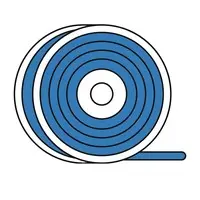ASA Filament Print Settings & Material Information
ASA print settings (Cura profile import, how it is done ...)
 Download Cura profile for our
Download Cura profile for our  ASA filament.
ASA filament.
 Here the matching 1.75mm
Here the matching 1.75mm  ASA filaments.
ASA filaments.
 Data sheet for our
Data sheet for our  ASA filament.
ASA filament.
ASA material summary
ASA (Acrylonitrile Styrene Acrylate) filament is not only simply weatherproof ABS, it is also stronger and more flexible than ABS.
ASA filament is resistant to oils, greases and higher temperatures.
The added UV resistance makes it perfect for outdoor use.
ASA material produces an odor when printed and harmful substances can be expelled.
A room with good ventilation should therefore be considered.
When cooling, ASA tends to warp, so the ambient temperature in the printer's installation space must be controlled and kept constant.
Slight temperature changes (small drafts) can cause warping.
ASA advantages
ASA disadvantages
ASA print area (recommendations)
Since each 3D printer has its own parameter preferences, adjustments to the settings and fine-tuning are necessary to achieve optimal print results.
** depending on the printing bed adhesion method also slightly less (e.g. with BlueTape possibly 10 to 30°C less)
Spool dimensions
Compability:
Our filaments are suitable for all common 3D printers (FDM / FFF - Fused Deposition Modeling / Fused Filament Fabrication).
Nevertheless, the instructions of the printer manufacturer regarding nozzle diameter, filament material, filament diameter and coil dimensions should be observed.
Storage:
Due to the hygroscopic property (ability to bind water) of some materials, we recommend all filaments indoors to store at room temperature and of course dry. Air-tight ZIP bags or containers with the desiccant SILICA are well suited for this.
The filaments should not hang on the printer for a long time, but always be airtight when not in use and stored with sufficient SILICA sealed.
It is also recommended to dry the filament (especially NYLON and PVA materials) before use (see section "Drying")
Desiccation (drying):
Due to the temperature differences on the transport route or through the storage itself, air may have sneaked into the packaging film. Often, the material may have absorbed some moisture between the manufacturing process and sealing (NYLON and PVA are extremely hygroscopic).
Therefore, we recommend drying overnight in a dehydrator (vegetable dryer) or a few hours in a convection oven (filament and coil only, without foil).
SPECIALTY with transparent colors!
Low humidity has no or hardly any effect on "colored" filaments, only with transparent filaments, some moisture can already lead to cloudiness.
A table with common drying times and temperatures per material is attached. A lump-sum duration for the drying is not to call. Because it depends on how much moisture the filament has already pulled.
A test pressure before drying should serve as the starting point.
The drying time should be tested with about 100g of filament, which has previously separated from the coil. So we say 3x 100g filament in the oven, the first takes after 30 min, the second after 60 min and the third after 120 min out. Afterwards you make another test print with each part. The experiences made can then be transferred to the entire coil. Or if you are not in a hurry, the filament roll in a dehydrator (vegetable dryer) for a few days should also lead to the desired success.
ABS at 50°C to 80°C approx. 4h* with circulating air
PETG at 50°C to 80°C approx. 4h* with circulating air
NYLON at 60°C to 80°C approx. 8h* with circulating air
PVA at 60°C to 80°C approx. 8h* with circulating air
* Drying time varies depending on the degree of moisture in the filament and environmental influences.
It should also be noted whether the coil will withstand the temperature you have chosen.
 ASA filament.
ASA filament. ASA filaments.
ASA filaments.  ASA filament.
ASA filament.
ASA (Acrylonitrile Styrene Acrylate) filament is not only simply weatherproof ABS, it is also stronger and more flexible than ABS.
ASA filament is resistant to oils, greases and higher temperatures.
The added UV resistance makes it perfect for outdoor use.
ASA material produces an odor when printed and harmful substances can be expelled.
A room with good ventilation should therefore be considered.
When cooling, ASA tends to warp, so the ambient temperature in the printer's installation space must be controlled and kept constant.
Slight temperature changes (small drafts) can cause warping.
ASA advantages
- high UV resistance, no fading even after prolonged exposure
- smoothing or dissolving of the surface in acetone possible
- resistance to greases and oils
- reworkable, drilling, turning, milling etc.
- good scratch resistance and resistant surface
- dcomparatively high operating temperatures possible (85 - 100 °C)
ASA disadvantages
- strong warping possible
- Heating bed and adhesion promoter advantageous for better adhesion
- pungent odor may occur during printing
- amount of evaporation during printing higher than with other filaments
- released amount of substances can be harmful (ventilate room well)
- closed installation room including filter or exhaust air necessary
- allow for approx. 1.5 - 2.5% shrinkage for dimensional accuracy
ASA print area (recommendations)
| Print temperature: | 240°C | to | 260°C |
| Print bed temperature:** | 100°C | to | 120°C |
| Print speed: | 40mm/s | to | 80mm/s |
| Travel speed: | 70mm/s | to | 150mm/s |
Since each 3D printer has its own parameter preferences, adjustments to the settings and fine-tuning are necessary to achieve optimal print results.
** depending on the printing bed adhesion method also slightly less (e.g. with BlueTape possibly 10 to 30°C less)
Spool dimensions
| Z3D 3D-Drucker-Filament.de |
1kg (net) | 0,5kg (net) |
| Outer Ø: | 200mm | 200mm |
| Inne hole: | 53mm | 53mm |
| Thickness: | 65mm | 38mm |
| eSun | 1kg (net) | 0,5kg (net) |
| Outer Ø: | 200mm | 200mm |
| Inner hole: | 52mm | 52mm |
| Thickness: | 70mm | 42mm |
General information about our filaments
Compability:
Our filaments are suitable for all common 3D printers (FDM / FFF - Fused Deposition Modeling / Fused Filament Fabrication).
Nevertheless, the instructions of the printer manufacturer regarding nozzle diameter, filament material, filament diameter and coil dimensions should be observed.
Storage:
Due to the hygroscopic property (ability to bind water) of some materials, we recommend all filaments indoors to store at room temperature and of course dry. Air-tight ZIP bags or containers with the desiccant SILICA are well suited for this.
The filaments should not hang on the printer for a long time, but always be airtight when not in use and stored with sufficient SILICA sealed.
It is also recommended to dry the filament (especially NYLON and PVA materials) before use (see section "Drying")
Desiccation (drying):
Due to the temperature differences on the transport route or through the storage itself, air may have sneaked into the packaging film. Often, the material may have absorbed some moisture between the manufacturing process and sealing (NYLON and PVA are extremely hygroscopic).
Therefore, we recommend drying overnight in a dehydrator (vegetable dryer) or a few hours in a convection oven (filament and coil only, without foil).
SPECIALTY with transparent colors!
Low humidity has no or hardly any effect on "colored" filaments, only with transparent filaments, some moisture can already lead to cloudiness.
A table with common drying times and temperatures per material is attached. A lump-sum duration for the drying is not to call. Because it depends on how much moisture the filament has already pulled.
A test pressure before drying should serve as the starting point.
The drying time should be tested with about 100g of filament, which has previously separated from the coil. So we say 3x 100g filament in the oven, the first takes after 30 min, the second after 60 min and the third after 120 min out. Afterwards you make another test print with each part. The experiences made can then be transferred to the entire coil. Or if you are not in a hurry, the filament roll in a dehydrator (vegetable dryer) for a few days should also lead to the desired success.
Drying times (recommendations):
PLA at 40°C to 50°C approx. 4h* with circulating airABS at 50°C to 80°C approx. 4h* with circulating air
PETG at 50°C to 80°C approx. 4h* with circulating air
NYLON at 60°C to 80°C approx. 8h* with circulating air
PVA at 60°C to 80°C approx. 8h* with circulating air
* Drying time varies depending on the degree of moisture in the filament and environmental influences.
It should also be noted whether the coil will withstand the temperature you have chosen.
